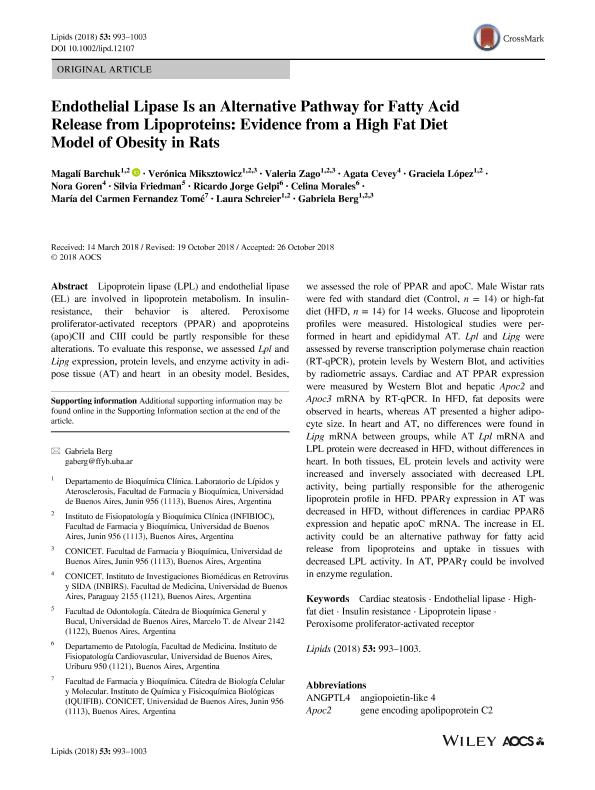Artículo
Endothelial Lipase Is an Alternative Pathway for Fatty Acid Release from Lipoproteins: Evidence from a High Fat Diet Model of Obesity in Rats
Barchuk, Magalí ; Miksztowicz, Verónica Julieta
; Miksztowicz, Verónica Julieta ; Zago, Valeria
; Zago, Valeria ; Cevey, Ágata Carolina
; Cevey, Ágata Carolina ; López, Graciela; Goren, Nora Beatriz
; López, Graciela; Goren, Nora Beatriz ; Friedman, Silvia; Gelpi, Ricardo Jorge
; Friedman, Silvia; Gelpi, Ricardo Jorge ; Morales, Maria Celina; Fernandez Tomé, María del Carmen; Schreier, Laura Ester; Berg, Gabriela Alicia
; Morales, Maria Celina; Fernandez Tomé, María del Carmen; Schreier, Laura Ester; Berg, Gabriela Alicia
 ; Miksztowicz, Verónica Julieta
; Miksztowicz, Verónica Julieta ; Zago, Valeria
; Zago, Valeria ; Cevey, Ágata Carolina
; Cevey, Ágata Carolina ; López, Graciela; Goren, Nora Beatriz
; López, Graciela; Goren, Nora Beatriz ; Friedman, Silvia; Gelpi, Ricardo Jorge
; Friedman, Silvia; Gelpi, Ricardo Jorge ; Morales, Maria Celina; Fernandez Tomé, María del Carmen; Schreier, Laura Ester; Berg, Gabriela Alicia
; Morales, Maria Celina; Fernandez Tomé, María del Carmen; Schreier, Laura Ester; Berg, Gabriela Alicia
Fecha de publicación:
10/2018
Editorial:
Springer Heidelberg
Revista:
Lipids
ISSN:
0024-4201
Idioma:
Inglés
Tipo de recurso:
Artículo publicado
Clasificación temática:
Resumen
Lipoprotein lipase (LPL) and endothelial lipase (EL) are involved in lipoprotein metabolism. In insulin-resistance, their behavior is altered. Peroxisome proliferator-activated receptors (PPAR) and apoproteins (apo)CII and CIII could be partly responsible for these alterations. To evaluate this response, we assessed Lpl and Lipg expression, protein levels, and enzyme activity in adipose tissue (AT) and heart in an obesity model. Besides, we assessed the role of PPAR and apoC. Male Wistar rats were fed with standard diet (Control, n = 14) or high-fat diet (HFD, n = 14) for 14 weeks. Glucose and lipoprotein profiles were measured. Histological studies were performed in heart and epididymal AT. Lpl and Lipg were assessed by reverse transcription polymerase chain reaction (RT-qPCR), protein levels by Western Blot, and activities by radiometric assays. Cardiac and AT PPAR expression were measured by Western Blot and hepatic Apoc2 and Apoc3 mRNA by RT-qPCR. In HFD, fat deposits were observed in hearts, whereas AT presented a higher adipocyte size. In heart and AT, no differences were found in Lipg mRNA between groups, while AT Lpl mRNA and LPL protein were decreased in HFD, without differences in heart. In both tissues, EL protein levels and activity were increased and inversely associated with decreased LPL activity, being partially responsible for the atherogenic lipoprotein profile in HFD. PPARγ expression in AT was decreased in HFD, without differences in cardiac PPARδ expression and hepatic apoC mRNA. The increase in EL activity could be an alternative pathway for fatty acid release from lipoproteins and uptake in tissues with decreased LPL activity. In AT, PPARγ could be involved in enzyme regulation.
Archivos asociados
Licencia
Identificadores
Colecciones
Articulos(INBIRS)
Articulos de INSTITUTO DE INVESTIGACIONES BIOMEDICAS EN RETROVIRUS Y SIDA
Articulos de INSTITUTO DE INVESTIGACIONES BIOMEDICAS EN RETROVIRUS Y SIDA
Articulos(IQUIFIB)
Articulos de INST.DE QUIMICA Y FISICO-QUIMICA BIOLOGICAS "PROF. ALEJANDRO C. PALADINI"
Articulos de INST.DE QUIMICA Y FISICO-QUIMICA BIOLOGICAS "PROF. ALEJANDRO C. PALADINI"
Articulos(OCA HOUSSAY)
Articulos de OFICINA DE COORDINACION ADMINISTRATIVA HOUSSAY
Articulos de OFICINA DE COORDINACION ADMINISTRATIVA HOUSSAY
Citación
Barchuk, Magalí; Miksztowicz, Verónica Julieta; Zago, Valeria; Cevey, Ágata Carolina; López, Graciela; et al.; Endothelial Lipase Is an Alternative Pathway for Fatty Acid Release from Lipoproteins: Evidence from a High Fat Diet Model of Obesity in Rats; Springer Heidelberg; Lipids; 53; 10; 10-2018; 993-1003
Compartir
Altmétricas



